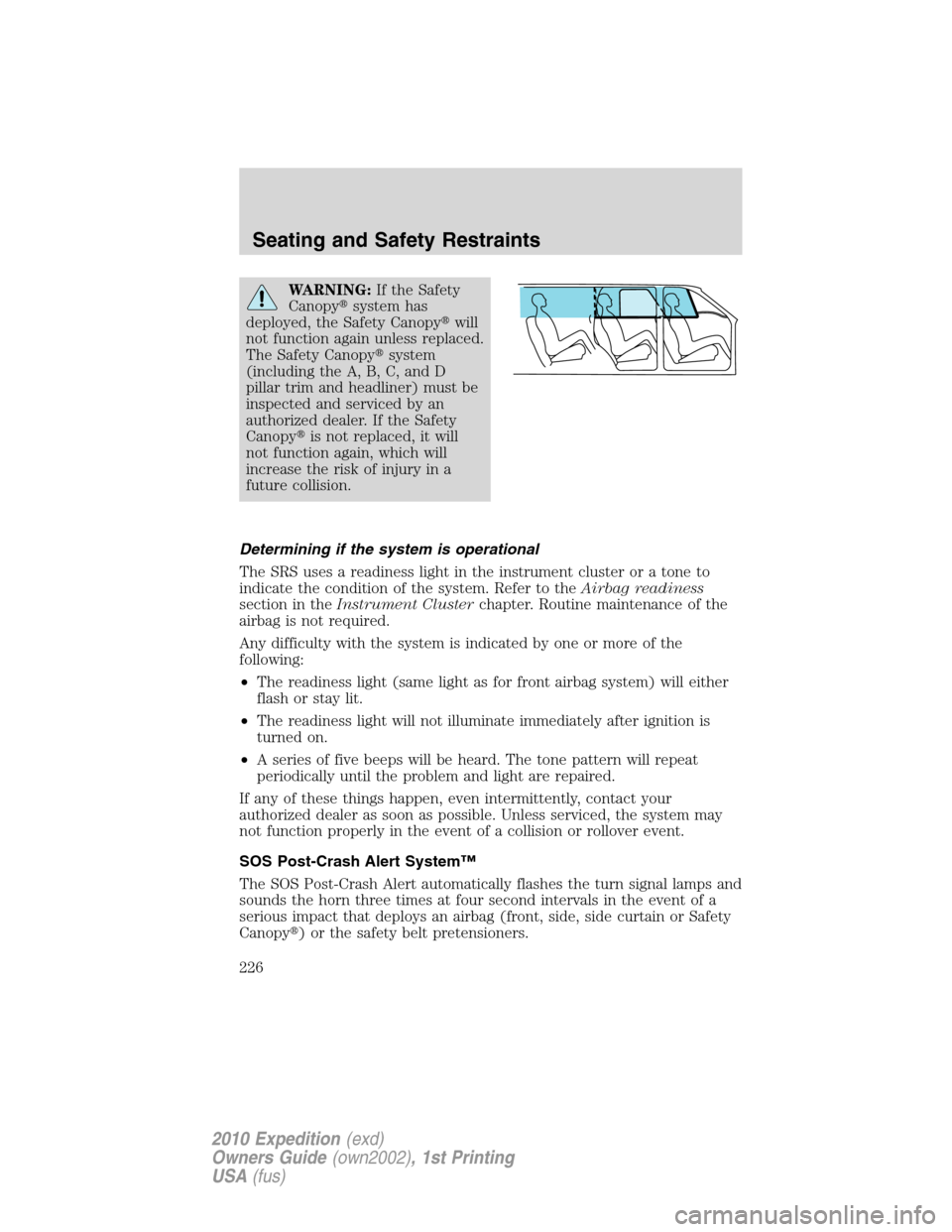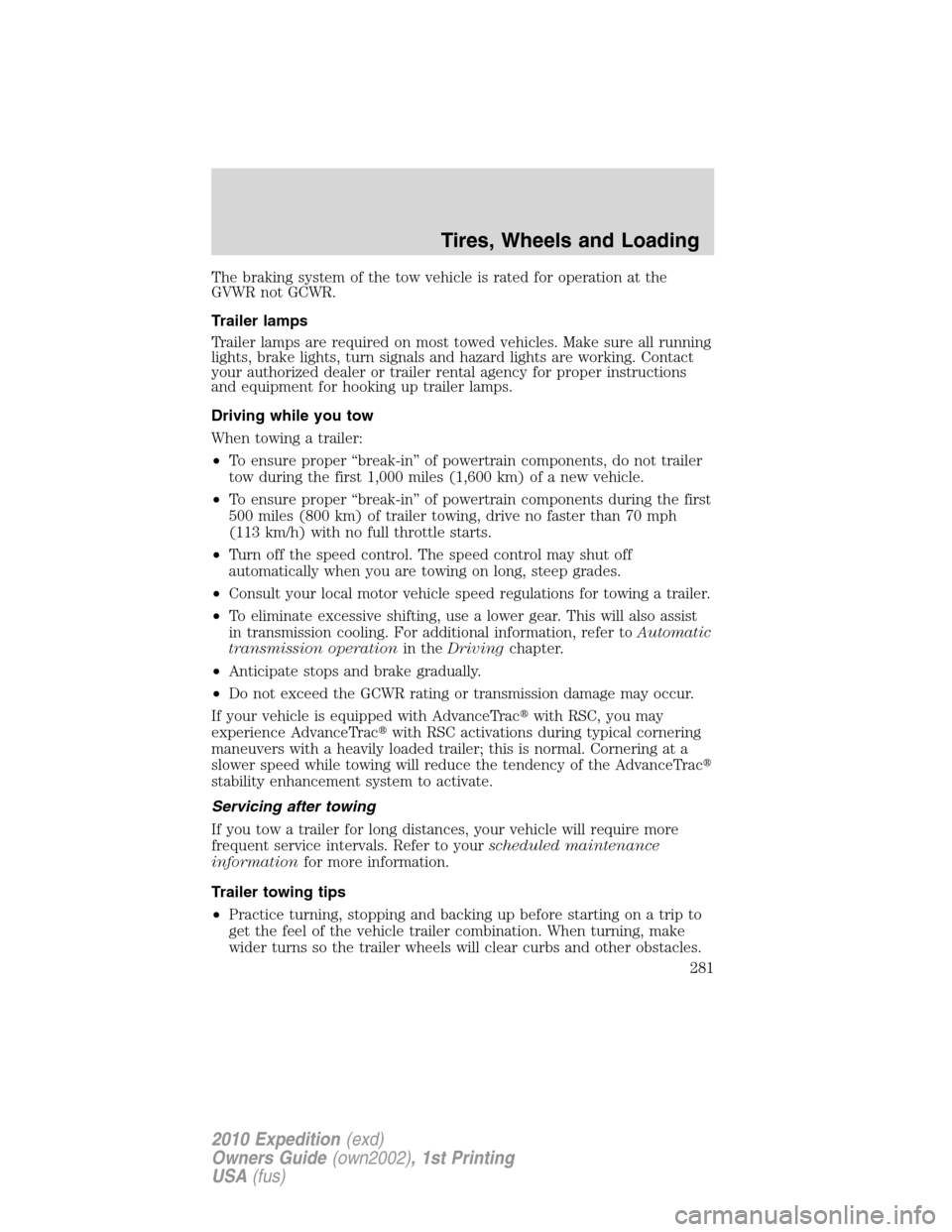Page 226 of 420

WARNING:If the Safety
Canopy�system has
deployed, the Safety Canopy�will
not function again unless replaced.
The Safety Canopy�system
(including the A, B, C, and D
pillar trim and headliner) must be
inspected and serviced by an
authorized dealer. If the Safety
Canopy�is not replaced, it will
not function again, which will
increase the risk of injury in a
future collision.
Determining if the system is operational
The SRS uses a readiness light in the instrument cluster or a tone to
indicate the condition of the system. Refer to theAirbag readiness
section in theInstrument Clusterchapter. Routine maintenance of the
airbag is not required.
Any difficulty with the system is indicated by one or more of the
following:
•The readiness light (same light as for front airbag system) will either
flash or stay lit.
•The readiness light will not illuminate immediately after ignition is
turned on.
•A series of five beeps will be heard. The tone pattern will repeat
periodically until the problem and light are repaired.
If any of these things happen, even intermittently, contact your
authorized dealer as soon as possible. Unless serviced, the system may
not function properly in the event of a collision or rollover event.
SOS Post-Crash Alert System™
The SOS Post-Crash Alert automatically flashes the turn signal lamps and
sounds the horn three times at four second intervals in the event of a
serious impact that deploys an airbag (front, side, side curtain or Safety
Canopy�) or the safety belt pretensioners.
Seating and Safety Restraints
226
2010 Expedition(exd)
Owners Guide(own2002), 1st Printing
USA(fus)
Page 281 of 420

The braking system of the tow vehicle is rated for operation at the
GVWR not GCWR.
Trailer lamps
Trailer lamps are required on most towed vehicles. Make sure all running
lights, brake lights, turn signals and hazard lights are working. Contact
your authorized dealer or trailer rental agency for proper instructions
and equipment for hooking up trailer lamps.
Driving while you tow
When towing a trailer:
•To ensure proper “break-in” of powertrain components, do not trailer
tow during the first 1,000 miles (1,600 km) of a new vehicle.
•To ensure proper “break-in” of powertrain components during the first
500 miles (800 km) of trailer towing, drive no faster than 70 mph
(113 km/h) with no full throttle starts.
•Turn off the speed control. The speed control may shut off
automatically when you are towing on long, steep grades.
•Consult your local motor vehicle speed regulations for towing a trailer.
•To eliminate excessive shifting, use a lower gear. This will also assist
in transmission cooling. For additional information, refer toAutomatic
transmission operationin theDrivingchapter.
•Anticipate stops and brake gradually.
•Do not exceed the GCWR rating or transmission damage may occur.
If your vehicle is equipped with AdvanceTrac�with RSC, you may
experience AdvanceTrac�with RSC activations during typical cornering
maneuvers with a heavily loaded trailer; this is normal. Cornering at a
slower speed while towing will reduce the tendency of the AdvanceTrac�
stability enhancement system to activate.
Servicing after towing
If you tow a trailer for long distances, your vehicle will require more
frequent service intervals. Refer to yourscheduled maintenance
informationfor more information.
Trailer towing tips
•Practice turning, stopping and backing up before starting on a trip to
get the feel of the vehicle trailer combination. When turning, make
wider turns so the trailer wheels will clear curbs and other obstacles.
Tires, Wheels and Loading
281
2010 Expedition(exd)
Owners Guide(own2002), 1st Printing
USA(fus)
Page 379 of 420

When the engine is cold, check the
level of the engine coolant in the
reservoir.
•The engine coolant should be at the FULL COLD level or within the
COLD FILL RANGE as listed on the engine coolant reservoir
(depending upon application).
•Refer toscheduled maintenance informationfor service interval
schedules.
•Be sure to read and understandPrecautions when servicing your
vehiclein this chapter.
If the engine coolant has not been checked at the recommended interval,
the engine coolant reservoir may become low or empty. If the reservoir is
low or empty, add engine coolant to the reservoir. Refer toAdding
engine coolantin this chapter.
Note:Automotive fluids are not interchangeable; do not use engine
coolant, antifreeze or windshield washer fluid outside of its specified
function and vehicle location.
Adding engine coolant
When adding coolant, make sure it is a 50/50 mixture of engine coolant
and distilled water. Add the mixture to the coolant reservoir,when the
engine is cool,until the appropriate fill level is obtained.
WARNING:Do not add engine coolant when the engine is hot.
Steam and scalding liquids released from a hot cooling system
can burn you badly. Also, you can be burned if you spill coolant on hot
engine parts.
WARNING:Do not put engine coolant in the windshield washer
fluid container. If sprayed on the windshield, engine coolant
could make it difficult to see through the windshield.
Maintenance and Specifications
379
2010 Expedition(exd)
Owners Guide(own2002), 1st Printing
USA(fus)
Page 404 of 420

Item Capacity Ford part nameFord part number /
Ford specification
Transfer case fluid (4X4)1.6-1.8 quarts
(1.5-1.7L)Motorcraft Transfer
Case FluidXL–12 /
—
Windshield washer fluid 4.5 quarts (4.1L)Motorcraft Premium
Windshield Washer
ConcentrateZC-32-A /
WSB-M8B16-A2
Fuel tank (Standard)28.0 gallons
(106.0L)——
Fuel tank
(Expedition EL – U.S. only)33.5 gallons
(126.8L)
Fuel tank
(Expedition Max – Canada
only)33.5 gallons
(126.8L)
1Add the coolant type originally equipped in your vehicle.2Use of synthetic or synthetic blend motor oil is not mandatory. Engine oil need only meet the
requirements of Ford specification WSS-M2C930-A and the API Certification mark.3Indicates only approximate dry-fill capacity. Some applications may vary based on cooler size and
if equipped with an in-tank cooler.4Automatic transmissions that require MERCON�LV should only use MERCON�LV fluid. Refer to
scheduled maintenance informationto determine the correct service interval. Use of any fluid
other than the recommended fluid may cause transmission damage.5Add 4 oz. (118 ml) of Additive Friction Modifier XL-3 or equivalent for complete refill of Ford
Limited Slip rear axles.6Your vehicle’s rear axle is filled with a synthetic rear axle lubricant and is considered lubricated
for life. These lubricants are not to be checked or changed unless a leak is suspected, service is
required or the axle has been submerged in water. The axle lubricant should be changed any time
the axle has been submerged in water.
Maintenance and Specifications
404
2010 Expedition(exd)
Owners Guide(own2002), 1st Printing
USA(fus)